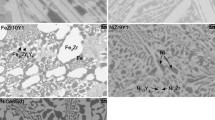Abstract
A Zr-0.5 Y alloy was found to oxidize about 6 times faster than pure zirconium over the temperature range of 400 to 565°C. The activation energies were nearly identical (∼32 kcal/mole). The activation energies correspond to grain boundary diffusion of oxygen through the scale. The higher oxidation rate of the alloy was attributed to a higher anion vacancy concentration and the assumption that diffusion sites in the lattice and boundaries were in local equilibrium. Measurements on yttria-doped zirconia showed that ionic conductivity was increased markedly by yttrium and extended over a wide range of oxygen pressure. The defect structure of the doped oxide was changed to one of oxygen vacancies, even at the high end of the oxygen pressure range, 10−8 to 0.2 atm, over which pure ziconia contains oxygen interstitials. The doped oxide was found to be extrinsic over the entire range of oxygen pressure and, although ionic conductivity predominated, electronic conductivity was still appreciable. The electronic conductivity, however, was still sufficiently high so that electron transport was not rate-controlling in the predominantly ionic-conducting scale.
Similar content being viewed by others
References
C. Wagner,Z. Phys. Chem., Abt. B,21, 25 (1933).
P. Kofstad,High-Temperature Oxidation of Metals (John Wiley and Sons, New York, 1966).
D. L. Douglass,The Metallurgy of Zirconium (International Atomic Energy Agency, Vienna, Special Supplement, 1971).
M. M. Nasrallah and D. L. Douglass,J. Electrochem. Soc. 121, 255 (1974).
R. J. Hussey and W. W. Smeltzer,J. Electrochem. Soc. 111, 564 (1964).
F. J. Keneshea and D. L. Douglass,Oxid. Met. 3, 1 (1970).
W. W. Smeltzer, R. R. Haering, and J. S. Kirkaldy,Acta Metall. 9, 880 (1961).
R. W. Vest, N. M. Tallan, and W. C. Tripp,J. Am. Ceram. Soc. 47, 635 (1964).
J. Rudolph,Z. Naturforsch., Teil A 14, 727 (1959).
A. Kumar, D. Rajdev, and D. L. Douglass,J. Am. Ceram. Soc. 55, 439 (1972).
D. L. Douglass and C. Wagner,J. Electrochem. Soc. 113, 671 (1966).
D. J. Poulton and W. W. Smeltzer,J. Electrochem. Soc. 117, 378 (1970).
M. F. Lasker and R. A. Rapp,Z. Phys. Chem. (Frankfurt am Main) 49, 198 (1966).
Author information
Authors and Affiliations
Rights and permissions
About this article
Cite this article
Nasrallah, M.M., Douglass, D.L. The oxidation behavior of a Zr-0.5Y alloy. Oxid Met 9, 357–365 (1975). https://doi.org/10.1007/BF00613535
Received:
Issue Date:
DOI: https://doi.org/10.1007/BF00613535




